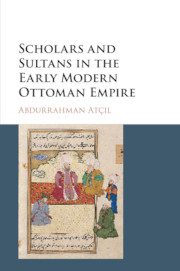Book contents
- Frontmatter
- Dedication
- Contents
- List of Tables
- Notes on Usage
- Acknowledgments
- Introduction
- Part I Scholars during the Early Ottoman Period (1300–1453)
- Part II The Formation of the Hierarchy (1453–1530)
- Part III The Consolidation of the Hierarchy (1530–1600)
- 6 The Focus of Attention Changes
- 7 The Ascendance of Dignitary Scholar-Bureaucrats (Mevali)
- 8 The Growth and Extension of the Hierarchy
- 9 The Rules and Patterns of Differentiation among Scholar-Bureaucrats
- 10 The Integration of Scholar-Bureaucrats in Multiple Career Tracks
- Conclusion
- Glossary
- Bibliography
- Index
8 - The Growth and Extension of the Hierarchy
from Part III - The Consolidation of the Hierarchy (1530–1600)
Published online by Cambridge University Press: 24 November 2016
- Frontmatter
- Dedication
- Contents
- List of Tables
- Notes on Usage
- Acknowledgments
- Introduction
- Part I Scholars during the Early Ottoman Period (1300–1453)
- Part II The Formation of the Hierarchy (1453–1530)
- Part III The Consolidation of the Hierarchy (1530–1600)
- 6 The Focus of Attention Changes
- 7 The Ascendance of Dignitary Scholar-Bureaucrats (Mevali)
- 8 The Growth and Extension of the Hierarchy
- 9 The Rules and Patterns of Differentiation among Scholar-Bureaucrats
- 10 The Integration of Scholar-Bureaucrats in Multiple Career Tracks
- Conclusion
- Glossary
- Bibliography
- Index
Summary
During the period of consolidation, new educational and judicial positions were created, and the legal and technical groundwork for the control of existing scholarly positions was enhanced. Thus, a greater number of scholar-bureaucrats could be employed. Meanwhile, the differentiation of scholarly positions and their organization in a particular order by rank gained momentum and facilitated the development of objective rules regarding the appointment and promotion of scholar-bureaucrats.
This chapter investigates the dramatic increase in the number of positions in which scholar-bureaucrats could serve and their stratification during the period of consolidation. The construction of new madrasas by the Ottoman dynasty and elite was an important factor in these changes, along with the differentiation of new and existing madrasas on the basis of the rank of each school's founder, location, and endowment. The officials of the central government exhibited an interest in controlling the endowments, a concern that went hand in hand with the extension of the hierarchy. Also during this period, many judgeships were incorporated into the official hierarchy, a development mostly relying on the expansion of land surveys and the ensuing differentiation of judgeships based on the estimated revenue they produced. Moreover, new administrative techniques, such as rotation, limited tenures, and an interim period between positions, made it possible to keep a greater number of scholar-bureaucrats affiliated with the central government.
The Construction of New Madrasas
The establishment of social institutions reached an apogee in terms of the number and size of institutions and endowments during the period under study. During Süleyman's reign alone, more than 100 madrasas were established and endowed. During the reigns of Selim II, Murad III, and Mehmed III combined, at least 64 madrasas were constructed.
This abundance of architectural projects in general and of new madrasas in particular had much to do with the augmentation of centralized control all over the empire after 1530. Benefiting from the wealth that was flowing to the center from the provinces, the Ottoman dynasty and elite undertook architectural patronage so as to assert their power. In addition, as the bureaucracy expanded, there arose a particular incentive to establish new madrasas where officials would be trained to fill the increasing number of official positions in both the center and the provinces.
- Type
- Chapter
- Information
- Scholars and Sultans in the Early Modern Ottoman Empire , pp. 145 - 169Publisher: Cambridge University PressPrint publication year: 2016

